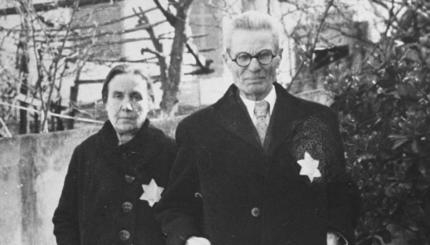This article, the second of two parts, looks at the ways Jewish mystics venerated the Hebrew letters. Jewish mystics considered the Hebrew letters to be a sort of Divine DNA, that when studied could reveal secrets of the Cosmos. Reprinted with permission from The Hebrew Alphabet: A Mystical Journey (Chronicle Books).
From the earliest metaphysical text known as the Sefer Yetzirah (“Book of Formation”), Jewish mystics have extolled the Hebrew alphabet as the manifestation of celestial patterns of energy. In a section that has long entranced kabbalistic (mystical) adepts, this ancient treatise vividly declares, “Twenty-two foundation letters: He ordained them, He hewed them, He combined them, He weighed them, He interchanged them. And He created with them the whole creation and everything to be created in the future.”
The Secrets of the Hebrew Letters
Based on this provocative notion, later Jewish visionaries stressed that mastery of the Hebrew alphabet in all its varied aspects allows the individual to gain supreme knowledge about the realm of matter. In particular, they regarded the Names of God as powerful devices in the hands of the knowledgeable. The correct permutation and pronunciation of certain Divine Names was believed to grant the ability to cure the dangerously ill, perceive events far away in time and space, and even to create a golem (a humanoid made from clay).
The 13th-century (Book of Splendor) is filled with references to the importance of the Hebrew alphabet as a celestial code or blueprint for the cosmos. Interestingly, modern science can supply an analogy to clarify this evocative concept: Just as we now regard the DNA molecule as a carrier of incredibly condensed information concerning the development of life, so too have kabbalists viewed the Hebrew language of Scripture as a cipher describing the universe. The Zohar relates that, “God looked into [the letters] of the and created the universe.”

Help us keep Jewish knowledge accessible to millions of people around the world.
Your donation to My Jewish Learning fuels endless journeys of Jewish discovery. With your help, My Jewish Learning can continue to provide nonstop opportunities for learning, connection and growth.
The Zohar affirms that every sentence, every phrase, every word, and even every letter of the Bible exists simultaneously on several levels of meaning. This sacred work clearly declares, “Woe unto those who see in the Law nothing but simple narratives and ordinary words! . . . Every word of the Law contains an elevated sense and a sublime mystery.”
In keeping with this notion, the Zohar devotes an entire section to the subtleties reflected in the single word Bereshit (usually translated as simply, “In the Beginning”), which opens the Book of Genesis and the Bible. Moreover, there is even a detailed discussion on the single letter Beit, which begins that first word. This approach to Scripture–and the Hebrew alphabet that communicates it–has remained central to the Kabbalah.
Hebrew Alphabet Yoga
Abraham ben Samuel Abulafia (c. 1240-1292) was among the most important Jewish mystics, due to his development of a meditative system based on the Hebrew alphabet. Believing that each of us can attain lofty spiritual states, Abulafia taught in a practical way that the Hebrew letters are a key pathway–in fact, the means for “the soul to actualize its potential with much greater ease” than with any other method. He emphasized that through proper understanding and practice, any person can use the Hebrew language as a means to arouse tremendous, intuitive capabilities. “Look at these holy letters with truth and belief,” he advised, “[it] will awaken the heart to thoughts of godly and prophetic images.”
Abulafia taught that the path to higher awareness is not particularly difficult. He recommended that initiates keep themselves in vibrant physical health, for in his view, the human body is a sacred vessel. Indeed, Abulafia’s yoga-like exercises, involving altered modes of breathing, require strong bodily vitality, or else actual harm might result.
The crucial aspect of Abulafia’s system is the utilization of the Hebrew language as the vehicle by which we ascend into the transcendent world. He poetically referred to this process as “knowing God through the method of the twenty-two letters of the Hebrew alphabet.” Abulafia specifically advised his followers, “Cleanse your body, and choose a special place where none will hear you, and remain altogether by yourself in isolation. Sit in one place in a room, or in the attic … it is best to begin by night.”
In Abulafia’s approach, the individual “begins to combine letters, a few or many, reversing and rolling them around rapidly, until [one’s] heart feels warm.” Those who adhere diligently to this technique, Abulafia declared, will eventually experience “a plenitude of saintly spirit … wisdom, understanding, good counsel and knowledge…. The spirit of the Lord will rest upon [them].”
During Abulafia’s colorful life, he inspired groups of followers throughout the Mediterranean region. To the present day, Abulafia’s creative means for awakening intuition are practiced by people around the world.
The Spiritual Power of Hebrew
In the ensuing centuries since Abulafia created his meditative system, many Jewish thinkers have extolled the spiritual power of the Hebrew alphabet. In the 16th century, Rabbi Isaac Luria taught that with the right inner focus–or kavvana–the individual could use the letters for tremendous spiritual development. To this end, he developed complex methods of visualization involving the letters.
According to legend, during the High Holy Days, Rabbi Luria felt that his prayers were especially effective, but an angel revealed to him that another’s prayers were even more potent. Quite intrigued, Rabbi Luria sought out and found the man, who seemed a most ordinary villager.
“What did you do on Rosh Hashonah?” the great rabbi asked. Apologetically, the man replied that he was unlearned and could not even read the entire Hebrew alphabet. So, when the Rosh Hashonah services began at his synagogue, he had recited the first 10 letters and said, “Please, O Master of the Universe, take my letters and form them into words that will please You.” And he had repeated this phrase all day long. Upon hearing the simple man’s account, Rabbi Luria then understood that the heartfelt prayers of the uneducated villager had been more exalted than all others.
The early leaders likewise extolled the Hebrew letters as vessels of the divine. Hasidism’s charismatic founder, Israel ben Eliezer–known as the Baal Shem Tov (“Master of the Good Name”)–strongly emphasized this notion, both through colorful parables to unschooled folk and advanced kabbalistic techniques to selected disciples. “Every physical thing contains these 22 letters,” he commented, “with which the world and everything in it are revealed.” On another occasion, the Baal Shem Tov remarked that, “All things were created through combinations of the 22 Hebrew letters.”
In Hasidism, the biblical craftsperson’s name, Bezalel, means “in the shadow of God,” for “to shadow” means “to emulate.” Thus did Bezalel, through the knowledge of the power of the letters and their permutations, emulate God in the act of Creation…
Hidden Significances
As Jewish mystics and sages have taught for millennia, the Hebrew alphabet bears a host of hidden significances. In traditional Jewish thought, each letter–its name, pictorial form, numerical equivalent, and respective position in the alphabet–is ordained by God. As a corollary of this principle, Jewish law has decreed for millennia that every letter of a Torah scroll must be perfect, or else the entire scroll is forbidden to be used. Not a fragment of a single letter may be omitted or distorted; nor may its individual character be compromised by contact with any other letters. Every word must be spelled correctly; one extra, transposed, or missing letter invalidates the whole scroll.
This religious dictum itself can be seen to impart a higher lesson: Each person, like each letter in the Torah, has a unique purpose in the divine plan. No one may impinge on another’s particular mission in life, just as no two letters may overlap.


